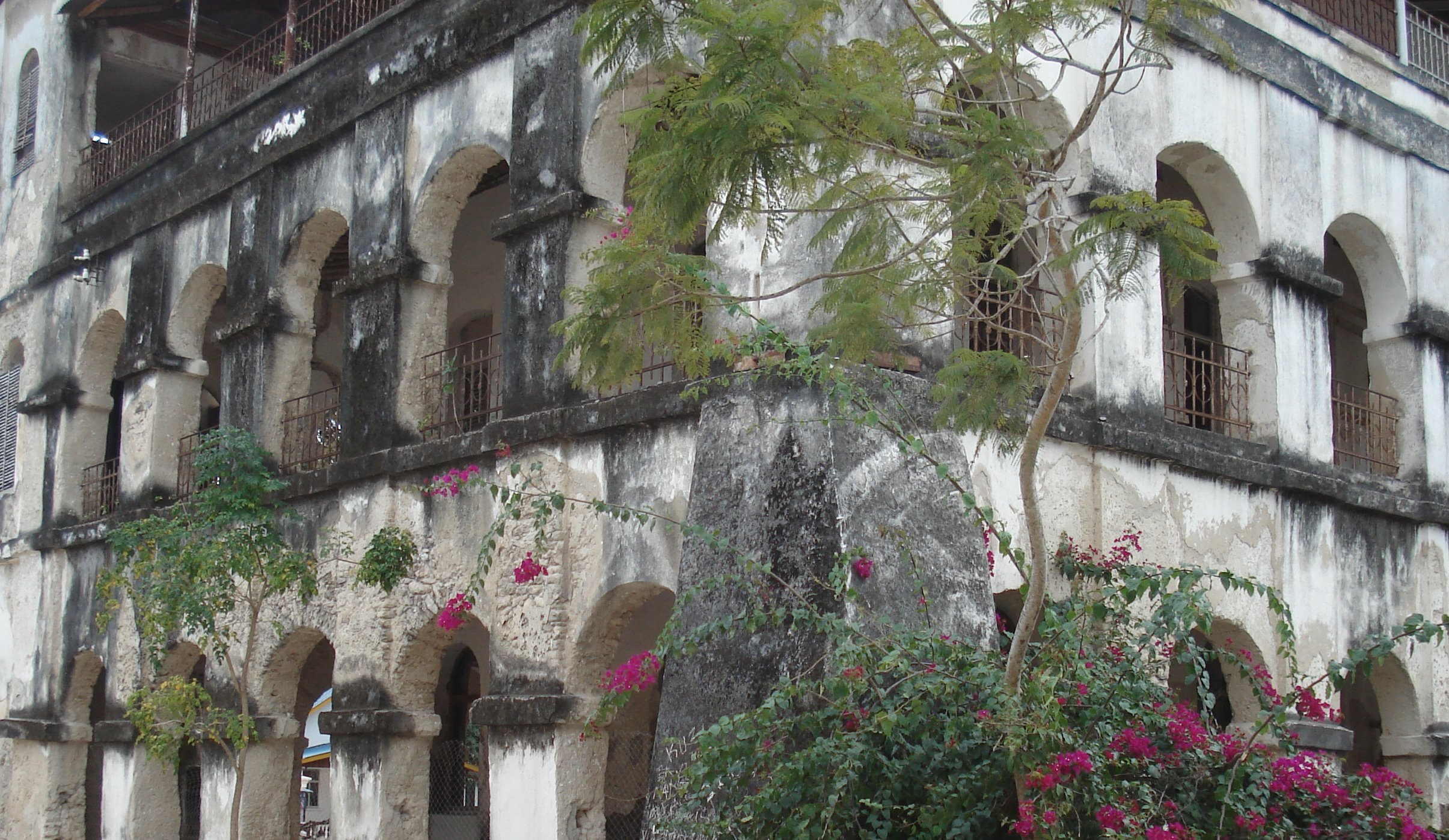- Bagamoyo
Infobox Settlement
official_name = Bagamoyo
other_name =
native_name =
nickname =
settlement_type =
motto =
imagesize = 300px
image_caption = Bagamoyo Mission Building
flag_size =
image_
seal_size =
image_shield =
shield_size =
image_blank_emblem =
blank_emblem_type =
blank_emblem_size =
mapsize =
map_caption =
mapsize1 =
map_caption1 =
image_dot_
dot_mapsize =
dot_map_caption =
dot_x = |dot_y =
pushpin_
pushpin_mapsize =300
pushpin_label_position =bottom
pushpin_map_caption =Location in Tanzania
subdivision_type = Country
subdivision_name = flag|Tanzania
subdivision_type1 = Region
subdivision_name1 =Pwani Region
subdivision_name2 =
subdivision_type3 =
subdivision_name3 =
subdivision_type4 =
subdivision_name4 =
government_footnotes =
government_type =
leader_title =
leader_name =
leader_title1 =
leader_name1 =
leader_title2 =
leader_name2 =
leader_title3 =
leader_name3 =
leader_title4 =
leader_name4 =
established_title =
established_date =
established_title2 =
established_date2 =
established_title3 =
established_date3 =
area_magnitude =
unit_pref =Imperial
area_footnotes =
area_total_km2 =
area_land_km2 =
area_water_km2 =
area_total_sq_mi =
area_land_sq_mi =
area_water_sq_mi =
area_water_percent =
area_urban_km2 =
area_urban_sq_mi =
area_metro_km2 =
area_metro_sq_mi =
area_blank1_title =
area_blank1_km2 =
area_blank1_sq_mi =
population_as_of =
population_footnotes =
population_note =
population_total =30,000
population_density_km2 =
population_density_sq_mi =
population_metro =
population_density_metro_km2 =
population_density_metro_sq_mi =
population_urban =
population_density_urban_km2 =
population_density_urban_sq_mi =
population_blank1_title =
population_blank1 =
population_blank2_title =
population_blank2 =
population_density_blank1_km2 =
population_density_blank1_sq_mi =
latd=6|latm=26|lats=|latNS=S
longd=38|longm=54|longs=|longEW=E
timezone =East Africa Time
utc_offset = +3
timezone_DST =
utc_offset_DST =
elevation_footnotes =
elevation_m =
elevation_ft =
postal_code_type =
postal_code =
area_code =
blank_name =
blank_info =
blank1_name =
blank1_info =
website =
footnotes =The town of Bagamoyo,
Tanzania , was founded at the end of the 18th century. It was the original capital ofGerman East Africa and was one of the most important trading ports along theEast Africa n coast. Today the town has about 30,000 inhabitants and is the capital of the District of Bagamoyo, recently being considered as aworld heritage site .Location
Bagamoyo is located at coord|6|26|S|38|54|E|region:TZ_type:city(30,000). It lies 75 km north of
Dar-es-Salaam on the coast of theIndian Ocean , close to the island ofZanzibar .History
Bagamoyo was the most important trading entrepot of the east central coast of Africa in the late 19th century. Bagamoyo's history has been influenced by Indian and Arab traders, by the German colonial government and by Christian missionaries.About 5 km south of Bagamoyo, the
Kaole Ruins with remnants of twomosque s and a couple oftomb s can be dated back to the13th century , showing the importance of Islam in those early Bagamoyo times. Until the middle of the 18th century, Bagamoyo was a small and insignificant trading center where most of the population were fishermen and farmers. The main trading goods were fish, salt, and gum, among other things.In the late 18th century Muslim families settled in Bagamoyo, all of which were relatives of
Shamvi la Magimba inOman . They made their living by enforcing taxes on the native population and by trading in salt, gathered from theNunge coast north of Bagamoyo.In the first half of the 19th century, Bagamoyo became a trading port forivory and theslave trade , with traders coming from the African interior, from places as far asMorogoro ,Lake Tanganyika andUsambara on their way toZanzibar . This explains the meaning of the word Bagamoyo ("Bwaga-Moyo") which means "Lay down your Heart" inKiswahili . It is disputed whether this refers to the slave trade which passed through the town (i.e. "give up all hope") or to the porters who rested in Bagamoyo after carrying 35lb cargos on their shoulders from the Great Lakes region (i.e. "take the load off and rest"). Since there is little evidence to support that Bagamoyo was a major slave port (Kilwa, much further south, has earned this status), and that tens of thousands of porters arrived at Bagamoyo annually in the latter half of the 19th century, it is more likely that the name of the town derives from the latter interpretation.The slave trade in East Africa was officially prohibited in the year 1873, but continued surreptitiously well to the end of the 19th century.
In 1868, Bagamoyo local rulers, known as majumbe, presented the
Catholic "Fathers of the Holy Ghost " with land for a mission north of the town, the first mission in East Africa. This caused resistance by the nativeZaramo people which was mediated by representatives of Sultan Majid and, after 1870, by SultanBarghash . Originally the mission was intended to house children who were rescued from slavery, but it soon expanded to a church, a school, and some workshops and farming projects.But Bagamoyo was not only a trade centre for ivory and
copra ; it was also a starting point for renowned European explorers. From Bagamoyo they moved out to find the source of the River Nile and explored the African inner lakes. Some of these wereRichard Francis Burton ,John Hanning Speke ,Henry Morton Stanley andJames Augustus Grant . Although often believed so,David Livingstone had never been to Bagamoyo in his lifetime. Only after his death he was laid out in the Old Church's tower (nowadays named Livingston Tower) to wait for the high tide to come in and ship his body to Zanzibar.Bagamoyo was the German headquarters of German East Africa (first under the auspices of the German East African Company and then the German Imperial Government) between 1886-1891. Dar es Salaam became the new capital of the colony in 1891. During
World War I , in 1916, a British air attack and naval bombardment was launched on Bagamoyo, the Germans were overrun and the German garrison taken.When the German Empire decided to build a railway from Dar es Salaam into the interior in 1905, Bagamoyo's importance began to decline.
Today
Today, Bagamoyo is a centre for
dhow sailboat building. TheDepartment of Antiquities in Tanzania is working to maintain the ruins of the colonial era in and around Bagamoyo and to revitalize the town. TheBagamoyo College of Arts (“Chuo cha Sanaa”) is an internationally famous arts college in Tanzania, teaching traditional Tanzanian painting, sculpture, drama, dancing and drumming.Notable inhabitants
*
Hukwe Zawose , traditional musicianReferences
External links
* [http://www.fotofenster-nohe.de/bagamoyo/index.htm Bagamoyo photos]
Wikimedia Foundation. 2010.

